Wrinkle-Free Clothes: Ironing Tips for Every Fabric Type
In the competitive clothing business, presentation is everything. Are you a small business owner or online retailer struggling to iron different fabrics without causing damage or spending excessive time battling stubborn creases? Wrinkled clothes can instantly devalue your brand and deter customers, which can lead to lost sales and a tarnished reputation. This guide provides expert ironing tips tailored for every fabric type, allowing you to achieve professional, wrinkle-free results.
1. Understanding ironing: The key to professional garment presentation
Ironing is the process of using heat and pressure to remove wrinkles and creases from fabrics. A heated iron, with its smooth, flat soleplate, glides across the fabric, gently applying pressure to relax the fibers and create a smooth, polished surface.
For clothing businesses, the act of ironing is far more than simply removing wrinkles. It is about elevating the perceived value of your garments and projecting a professional image through impeccably presented clothing.
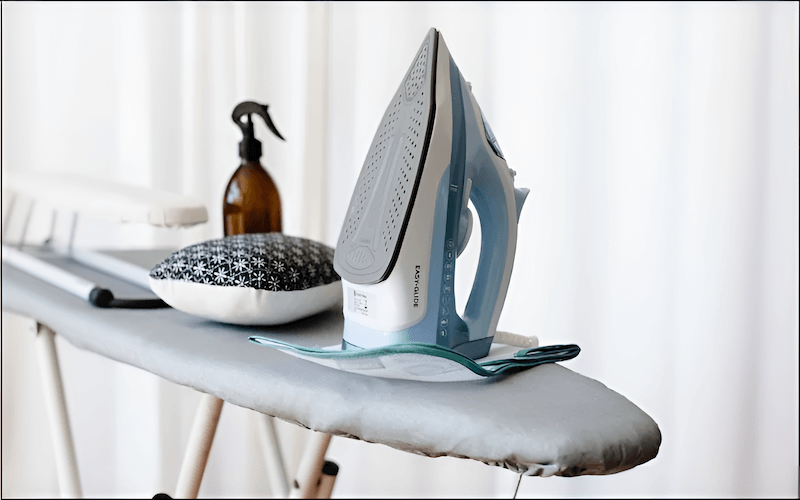
2. Why ironing matters for your clothing business: Beyond wrinkle removal
2.1 Enhancing garment appearance and brand image
Ironing is a cornerstone of garment care, with a direct impact on how customers perceive your clothing and your brand. Crisp, wrinkle-free clothes exude quality and attention to detail, leading to an immediate enhancement of visual appeal.
This polished presentation is crucial for attracting customers, boosting sales, and cultivating a positive brand image that signifies professionalism and high standards. It is about making a good first impression.
2.2 Extending garment lifespan and protecting inventory
Beyond aesthetics, ironing contributes to the longevity of your clothing inventory. By addressing wrinkles promptly, you prevent them from setting deeply into the fabric, which can lead to fiber damage and premature wear.
Regular ironing acts as a preventative measure, safeguarding your investment in inventory and reducing potential losses from damaged goods.

2.3 Optimizing stain removal effectiveness
Ironing, surprisingly, can even play a role in stain management. By gently pressing a garment before applying stain remover, you can prepare the fabric fibers to be more receptive to treatment. This pre-ironing step can enhance the effectiveness of stain removal products, helping you maintain the pristine condition of your clothing items. This is an added benefit.
3. Avoiding ironing mistakes: Potential risks and best practices
3.1 The importance of correct ironing techniques
Ironing offers numerous benefits; however, improper techniques can harm your garments. Execute ironing with a mindful approach, and you’ll find that ironing is a valuable practice. The right techniques are the key to reaping the rewards without risking damage.
3.2 Heat sensitivity and fabric types: Knowing your materials
Heat sensitivity varies across fabric types. Delicate materials like silk and synthetic blends are particularly heat-sensitive, and prone to damage at high temperatures. Scorching, melting, discoloration, and warping are all potential risks of using excessive heat. Check the care label on each garment to know the temperature.
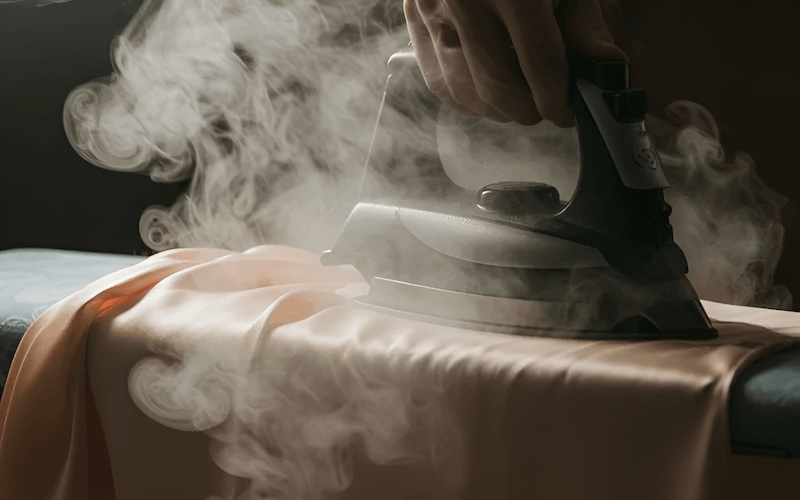
3.3 Fiber damage and how to prevent it
Excessive heat can weaken fabric fibers, especially in delicate materials like silk. This will reduce lifespan and compromise garment integrity. Prevent this from happening by meticulously controlling the temperature. Always adhere to recommended heat settings. Use a pressing cloth as a protective barrier between the iron and the fabric, especially for sensitive materials.
4. Essential ironing tips for efficiency and professional results
4.1 Setting up your ironing station for comfort and productivity
Creating an efficient and comfortable ironing station is crucial, especially for businesses with large clothing volumes. Position your ironing board on a flat, stable surface at a height that minimizes strain. The right lighting is also key. Organize your tools and garments for a smooth workflow.
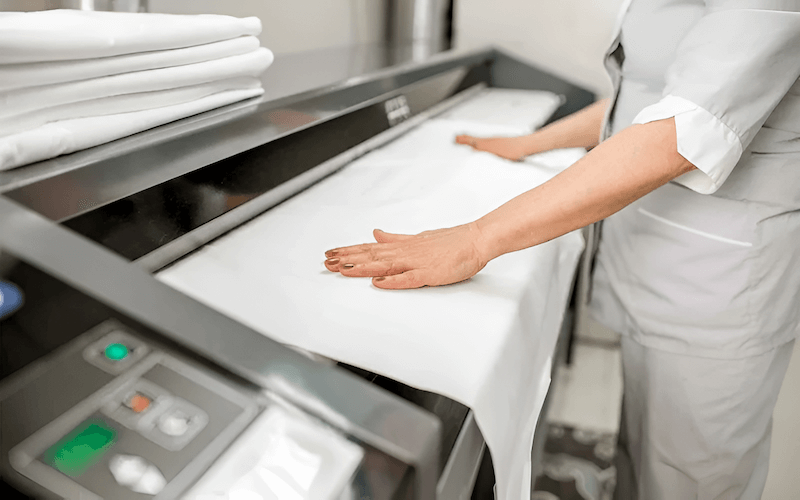
4.2 Inside out ironing: Protecting garment surfaces
Turn garments inside out before ironing to protect delicate outer surfaces, prints, and embellishments. This minimizes direct heat exposure to the garment’s visible side, preventing potential damage to colors, designs, and fabric textures, which is especially important for retail items. It can also make the ironing easier.
4.3 Systematic ironing: Section by section approach
A systematic approach is recommended. Begin with smaller, detailed areas like collars and cuffs before moving to larger panels. This ensures thoroughness and maintains the garment’s shape. A structured approach contributes to a more efficient and professional outcome.
4.4 Steam power: Taming stubborn wrinkles effectively
Leverage the power of steam. Most irons have a steam function that releases moisture to relax fabric fibers, making wrinkles easier to smooth out. For resistant creases, hold the iron slightly above the fabric and use a burst of steam. Steam is beneficial for fabrics like linen and cotton, known for wrinkling easily.
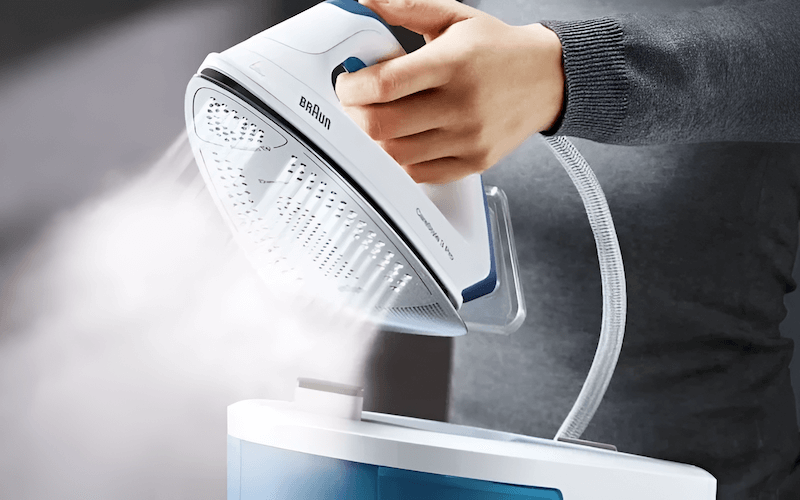
4.5 Immediate hanging or folding: Maintaining your hard work
As soon as you finish ironing a garment section, hang it or fold it neatly. This prevents new wrinkles from forming. For businesses preparing large quantities of clothing, this is essential to keep the garments presentation-ready.
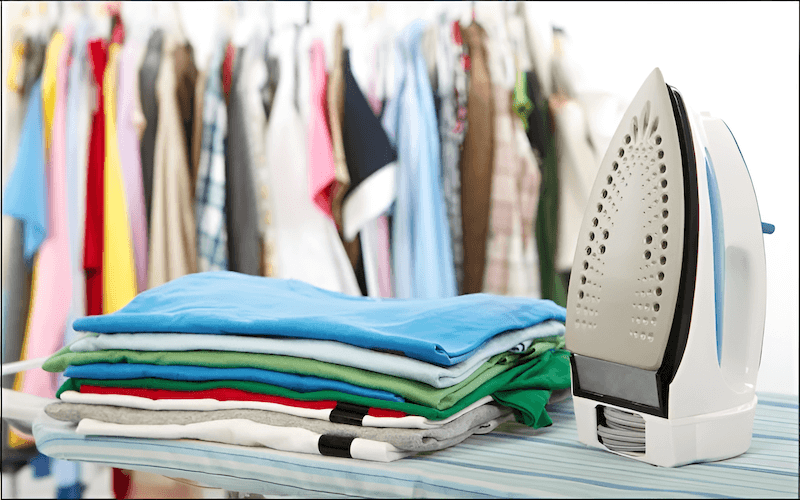
5. Mastering temperature settings: Ironing every fabric type with confidence
5.1 Understanding fabric care labels: Your first guide
Before ironing any garment, always consult the fabric care label, because these labels provide crucial information, including recommended ironing temperatures and any specific precautions. It is essential to familiarize yourself with common ironing symbols to decipher care instructions accurately and ensure you’re using the appropriate settings for each fabric type. These labels should provide the best indication of how the garment will react to heat, and also warn about things you should avoid, such as using steam.
5.2 Low-temperature fabrics (cool setting): Acetate, acrylic, nylon
Fabrics like acetate, acrylic, and nylon are very sensitive to heat and require low-temperature or cool iron settings. These synthetic materials can easily melt, distort, or develop a shine if ironed at higher temperatures. You should exercise extreme caution and always start with the lowest setting, gradually increasing if needed. Always monitor the fabric’s reaction carefully to avoid any damage.
5.3 Medium-temperature fabrics (Warm setting): Polyester, silk, satin, wool
Polyester, silk, satin, and wool can tolerate moderate heat. Use a medium or warm iron setting for these fabrics. For delicate items such as silk and satin, and for wool to prevent shine, always use a pressing cloth between the iron and the fabric. This pressing cloth creates a protective layer, diffusing the heat and preventing direct contact, which minimizes the risk of damage. A pressing cloth is essential for these items.
5.4 High-temperature fabrics (Hot setting): Linen, cotton, denim
Linen, cotton, and denim are more robust and can withstand higher ironing temperatures. Use a hot iron setting for these materials to effectively remove wrinkles. Steam is particularly beneficial for achieving crispness in cotton and linen. To achieve an extra-crisp finish, particularly on items like dress shirts or linen tablecloths, consider using spray starch, because this will work well with high heat ironing.
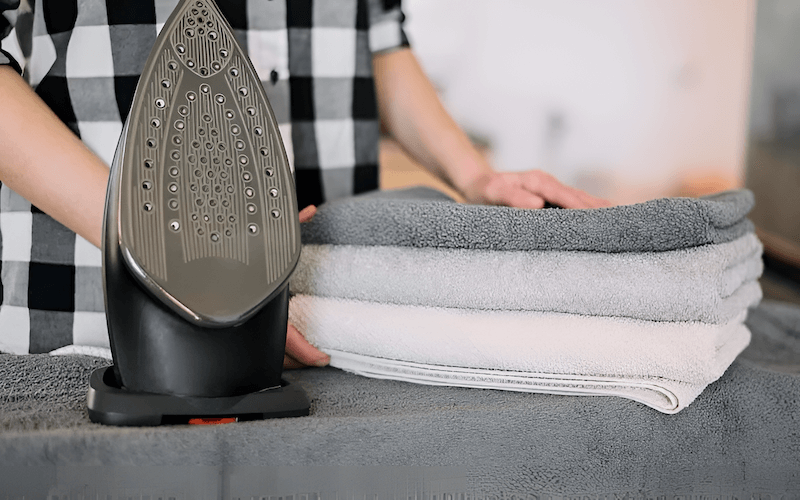
5.5 Quick reference temperature guide (Table)
| Fabric Type | Iron Temperature Setting | Additional Tips |
| Acetate, Acrylic, Nylon | Low (Cool) | Start low, monitor closely |
| Polyester, Silk, Satin, Wool | Medium (Warm) | Use pressing cloth, especially for silk |
| Linen, Cotton, Denim | High (Hot) | Use steam and starch for crispness |
6. The power of starch: Achieving extra crispness and structure
6.1 Starch spray benefits: Polished look and enhanced wrinkle removal.
Starch spray is a valuable tool to achieve a crisp, polished look. It adds stiffness and structure to fabrics, for a refined appearance. It can help with wrinkle removal. Starch spray helps to hold the pressed shape longer. This is an easy way to add a professional touch to your garments.
6.2 Best uses for starch in a clothing business context
In a clothing business, starch spray is particularly useful for certain garment types and presentation needs. Starch is great for formal and business attire such as dress shirts, blouses, and suits. This will create sharp creases and a professional edge. Starch is helpful for thin or lightweight fabrics, like those that look limp. Garments intended for display or photoshoots will also benefit from starch.
6.3 Cautions and best practices with starch spray
Always use starch spray correctly, and that starts with testing. Test the spray on a small, inconspicuous area of the fabric first. Apply starch sparingly to avoid excessive stiffness or starchy residue. Choose a type that is appropriate. Always follow the manufacturer’s instructions.
7. Step-by-step guide: Ironing pants for a sharp, professional crease
7.1 Preparation is key: Empty pockets and pre-treat wrinkles
Begin preparing your pants by emptying all pockets and closing any zippers or buttons. These steps will ensure a smooth, even ironing surface. If your pants are heavily wrinkled, you can lightly mist the fabric with water. The water helps make wrinkles easier to remove, and the pre-treatment of wrinkles is key.
7.2 Waistband and pockets first: Building a foundation
Start ironing with the waistband and pockets, working to create a solid base. Iron the waistband first, both inside and out. The pockets need to be pulled out fully and ironed. Ironing these areas first establishes a foundation for pressing the rest of the pants legs.
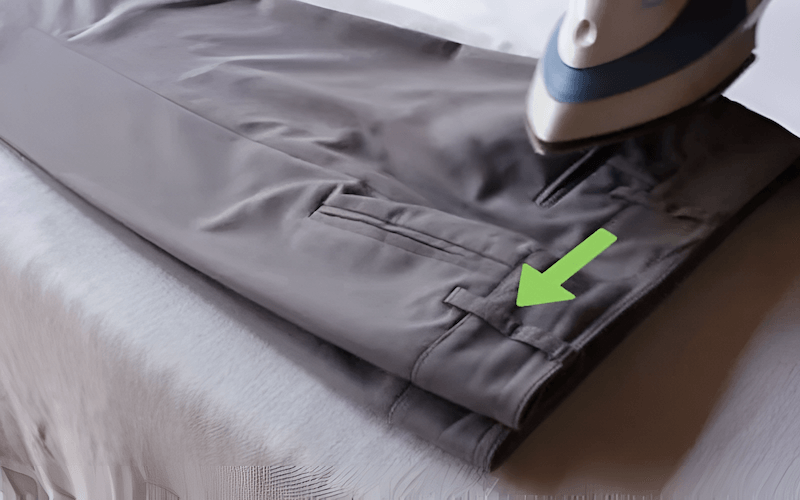
7.3 Ironing pant legs: Achieving sharp creases and smoothness
Now, iron each pant leg separately. Align the inseam and outseam of each leg to create a neat fold. If you are ironing dress pants requiring sharp creases, fold the leg along the desired crease line and press firmly, using steam if needed. For dress pants, always use a pressing cloth to prevent shine and scorching. When working with casual pants, a softer press without a sharp crease may be preferred.
7.4 Final touches: Hanging or folding to maintain the press
Once you’ve meticulously ironed the pants, hang them immediately, or fold them carefully, on a pants hanger. It is important to allow the fabric to cool and set into the wrinkle-free state. Quick action prevents new wrinkles.
8. Advanced ironing techniques: Elevating your garment care to the next level
8.1 Test first, iron smart: Preventing costly mistakes
Adopt a “test first, iron smart” approach, especially when dealing with unfamiliar fabrics or valuable inventory. Before ironing an entire garment, always test the iron’s heat on a small, hidden area, such as an inside seam or hem. This precautionary step can prevent costly mistakes like scorching or melting, safeguarding your merchandise from irreversible damage.
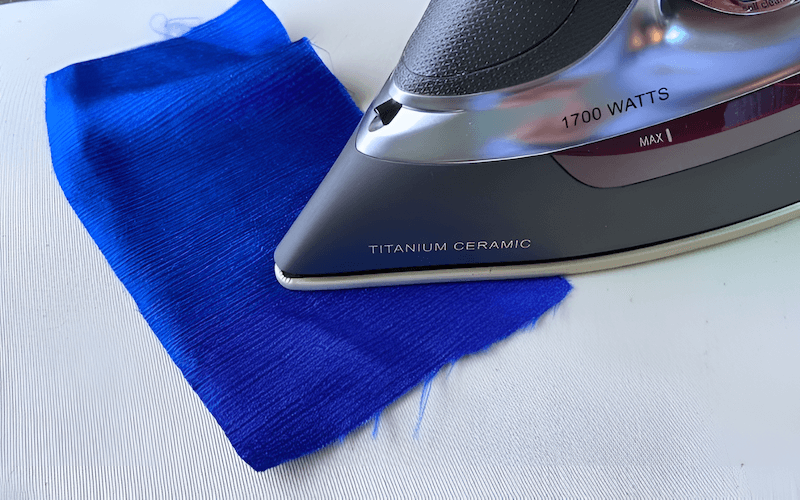
8.2 Section ironing mastery: Maintaining garment shape
Master the art of section ironing to maintain the intended shape of garments, particularly tailored items. This will help to ensure you don’t distort the garment structure, which can happen if you are not careful. By focusing on ironing specific sections—collars, cuffs, sleeves, and bodices—you avoid distorting the overall garment structure. This technique is especially crucial for preserving the shape and fit of structured clothing like jackets, blazers, and dresses.
8.3 The right motion: Smooth strokes for flawless results
Employing the right ironing motion is essential for flawless results. Use long, smooth, straight strokes along the fabric grain, instead of short, scrubbing motions. This technique prevents stretching or distorting the fabric and creates a smoother, more even finish. Avoid leaving the iron stationary on the garment, because this can lead to burns or scorch marks.
8.4 Immediate hanging: The golden rule of ironing
Consider immediate hanging as the “golden rule” of ironing. As soon as you finish ironing a garment, hang it up without delay. This simple yet critical step is paramount for allowing the fabric to cool and set in its wrinkle-free state. If you don’t hang the garment, your ironing efforts will be undone by new creases.
8.5 Damp cloth magic: Conquering stubborn wrinkles
For tackling exceptionally stubborn wrinkles, harness the magic of a damp cloth. Lay a slightly damp cloth (cotton or linen) over the wrinkled area and iron over the cloth. The steam generated from the damp cloth penetrates the fabric more deeply, effectively relaxing even the most resistant wrinkles. Use distilled water.

8.6 Vertical steaming: Quick refresh for hanging garments
Utilize the vertical steam function for a quick refresh of hanging garments. Vertical steaming is ideal for removing light wrinkles and creases from items that are already hanging, such as dresses, jackets, or delicate embellished garments that are difficult to iron on a board. It’s a convenient method for touch-ups and refreshing garments between wears or before display. This can also be used when you don’t have much time.
9. FAQs about ironing for clothing businesses
9.1 What’s the best type of iron for a clothing business handling various fabrics?
For a clothing business dealing with diverse fabrics, a steam iron with adjustable temperature settings is essential. Look for models with a high-quality soleplate, such as stainless steel or ceramic, for smooth gliding and even heat distribution. Features like auto shut-off are also beneficial for safety in a business environment. Consider investing in a reliable, durable iron that can withstand frequent use.
9.2 How often should I clean my iron, and how?
Regular iron cleaning is crucial to prevent residue buildup on the soleplate, which can transfer to garments. Clean your iron every 1-2 weeks with regular use. When the iron is cool, wipe the soleplate with a damp cloth to remove lint and residue. For stubborn buildup, use a commercial iron cleaner specifically designed for your soleplate type, following the product instructions carefully.
9.3 Is steaming or ironing better for delicate fabrics like silk?
Steaming is generally gentler for delicate fabrics like silk, as it uses moist heat to relax wrinkles without applying direct pressure from the soleplate. Ironing silk is possible but requires extra caution: use the lowest heat setting, a pressing cloth, and iron quickly and gently. Steaming is often the safer and preferred method for preserving the delicate nature of silk and similar fabrics.
9.4 How can I speed up the ironing process when dealing with large quantities of clothing?
To expedite ironing large quantities, optimize your workflow. Set up an efficient ironing station with everything within reach. Batch iron similar fabric types together to avoid constant temperature adjustments. Utilize the steam function effectively to reduce ironing time. Consider using multiple irons if volume is consistently high.
9.5 What are common ironing mistakes to avoid in a clothing business?
Common ironing mistakes to avoid in a clothing business include using excessively high heat, neglecting to check care labels, leaving the iron stationary on fabric, and skipping the use of a pressing cloth when needed. These mistakes can lead to fabric damage, scorching, and a less professional finish, ultimately impacting garment quality and customer perception.
10. Packlove – Providing garment care solutions for your business
At Packlove, we understand that in the clothing business, every detail matters, from the quality of your garments to their presentation. We have over 8 years of experience in the garment industry. We also understand the importance of proper garment care. Presenting clothing in pristine, wrinkle-free condition is as vital as having well-branded labels. While we specialize in enhancing your brand identity with custom labels and tags, we also want to support your business.
If you are looking for ways to elevate your brand and ensure your clothing always looks its best, explore how Packlove can help with your labeling and branding needs. Contact us today to learn more about our services and how we can support your clothing business. We are happy to help.
Visit our website at https://mypacklove.com/ or contact us [email protected] to explore our options and contact us for a free consultation.
Read more:
Mastering the art of ironing is a crucial skill for success in the clothing business. Through understanding fabric types, employing correct techniques, and avoiding common mistakes, you can elevate your brand. Investing time in proper ironing practices, from setting up an efficient station to utilizing steam, helps to make sure that your garments are always presented in a professional manner. The details matter. Ultimately, proper ironing leads to increased customer satisfaction, reduced returns, and a stronger brand image.






















